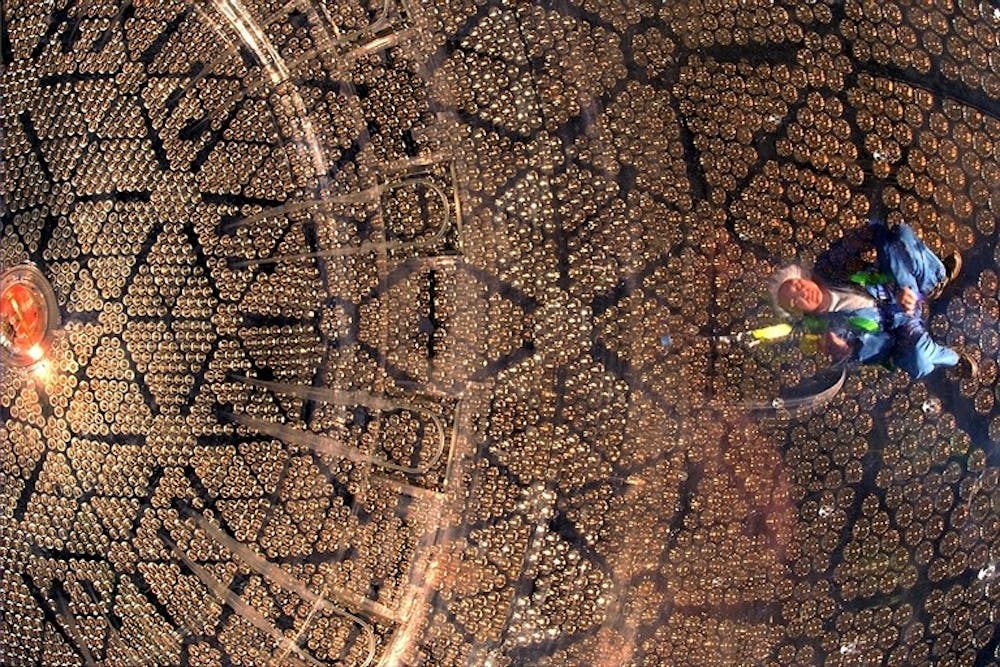With perseverance, a giant 1,000-ton “fishbowl” full of rare water and a man-made cavern 6,800 feet underground, Penn researchers contributed to a Nobel Prize-winning project that has revolutionized the modern world of physics.
Penn researchers were rewarded for their hard work this month when their contributions to science won the 2015 Nobel Prize in physics. The prize, which can be given to a maximum of three people, was jointly awarded to a Japanese and Canadian scientist who had led two separate projects studying neutrinos — subatomic particles millions smaller than electrons — in underground mines.
Penn research was critical in the Canadian project conducted at the Sudbury Neutrino Observatory, which was led by Arthur B. McDonald and funded by the Office of Nuclear Physics in the Department of Energy Office of Science. More than a dozen members of the Canadian team, which consisted of hundreds of researchers and technicians from all over the globe, were from Penn.
Neutrinos are the second-most abundant particle on earth, with 100 billion passing though just the tip of a finger every second. Until now, scientists had been puzzled by why their calculations detected far fewer neutrinos than predicted by theoretical models. The prize-winning research has revealed that the difference in calculations had occurred because neutrinos can “flip” type, implying that they have mass.
Physics professor Joshua Klein, who led the data analysis that produced the first results showing that neutrinos oscillated, said one of the reasons this discovery is so groundbreaking is that it challenges the Standard Model of Physics.
“[The] Standard Model, before we made this discovery, described every experiment that was ever done on earth to unbelievable precision, and now with the discovery of neutrino mass, we no longer have a theory that can make predictions,” Klein said.
He added that the new discovery opened up many new discussions in physics, such as how neutrinos get mass, and the relationship between neutrinos and their antiparticles, which could possibly be explored in the future to explain why the universe is made of matter and not antimatter.
The project began around 1989, and Klein made its first data acquisition in 2001 after joining the project when he was a postdoctoral student.
The experiment used a huge, underground spherical detector with a 40-foot diameter filled with 1,000 tons of heavy water, which physics professor Eugene Beier — the U.S. co-spokesperson for the SNO Collaboration — playfully referred to as a huge “fishbowl.” Heavy water, a very rare type of water that contains a scarce isotope of hydrogen, is so precious that the water filling the detector is worth $300 million.
Beier said the special properties of the heavy water made it ideal for interacting with neutrinos in a way that they can be detected. The spherical container was lined with 10,000 light sensors that looked for small flashes of light to detect the interactions of the neutrinos. The Penn team built cutting-edge electronics to read and analyze the results of the light sensors and transported it all the way from Philadelphia to Canada in a truck.
“We have a capability which is unusual for a university in that we can build large electronic systems that are very sensitive,” Beier said, emphasizing how this precise technology is usually only available in national labs.
The experiment detected all three types of neutrinos instead of only searching for the one initial kind that was expected to come from the sun, which is how it was able to discover that neutrinos change type.
The detector was placed far underground so that cosmic rays would not interfere with the highly sensitive sensors. Researchers and specialists went down with miners and even had to take the same training as underground contractors in preparation.
Instrumentation specialists Richard VanBerg and Mitchell Newcomer mentioned working underground was an unforgettable experience.
A cage-like, double-decker elevator with a capacity of about 80 people warped the team in under two minutes. The team members then walked a mile to a clean room, where they showered, changed and put on hairnets. Unlike the rest of the muddy cave, the clean room was absolutely pristine because even a tablespoon of mine dust in the detector would have ruined the experiment.
Team members spent eight to 10 hours underground each day. The higher air pressure underground would have made people feel tired more easily so they had to be extremely responsible in remembering their tools because they couldn’t easily back up to get them. Still, the challenge had its positives.
“It was a good bonding experience,” VanBerg said.
Newcomer, VanBerg, Klein and Beier agreed that Penn is unique in that it allows young people to gain hands-on experience working on groundbreaking projects. Many postdocs were able to directly work alongside the professionals and actively discuss ideas with them, while the experts tried to be as accessible as possible.
“When we sit in group meetings, we can ask about the details of what [students] are doing, and they can ask us and always fit it inside the bigger picture,” Klein said.









